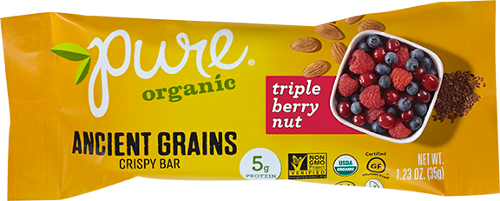Setting the Cereal Bar High
Interest in portable, tasty nutrition reaches new heights.
Photo from Pure Organic

The cereal bars market is maturing after years of strong growth, particularly in the United States, which is the largest market in the world. Global and U.S. launches of cereal and energy bars recorded by Innova Market Insights fell slightly in the 12 months to the end of June 2017, although numbers were still well above totals for the previous five years. The mature U.S. market saw just over a 50% rise in launch numbers over the previous five-year period (June 2012–2017). Meanwhile, the less well-developed regions of the world saw even more dynamic growth with a surge of more than 90% globally over the same period.
As interest in cereal bars has grown, the category has broadened to encompass a wide range of products, including granola/muesli, breakfast, nutrition, and energy and performance bars. With increased competition in this market, however, many product makers seek to highlight points of differentiation by combining features and blurring definitions, often carrying a range of ingredients and product claims designed to appeal to the widest possible audience seeking nutritious, tasty, and portable snacks in a highly competitive environment.
Market Differentiation: What’s In and What’s Out
The nutrition bars sub-category focuses specifically on health, but most products launched in the cereal bar market also use health claims. More than 83% of global launches recorded by Innova Market Insights in the 12 months to the end of June 2017 used at least one kind of health positioning; in the United States, nearly 95% of cereal bars launched in the same period had some kind of health positioning.
Whole-food nutrition and natural ingredients are key areas of interest, with clean labeling and “free from” continuing to be areas of focus. Nearly half of U.S. launches featured one or more claims relating to naturalness, no additives/preservatives, or organic certification. This figure rises to nearly two-thirds when GMO-free claims are also included. The growing use of GMO-free positionings has been apparent in the global food and drinks market in recent years, but has been especially prevalent in the United States and for cereals. Innova Market Insights estimates that 48% of newly launched products use this type of claim, up from around 10% five years previously.
Cereal bar launches with “free-from” positionings are not far behind clean labelling in the United States, with 64% featuring allergen-free, gluten-free, lactose-free, vegan, and vegetarian claims. Gluten-free is the leading health positioning for cereal bars as a whole. This positioning is used for more than 60% of all new product introductions.
Other key areas of interest include the use of whole grains, fiber, and, more recently, protein. Protein is now the most significant of the three, with “high/source of protein” claims used for 47% of launches in the 12 months to the end of June 2017, compared with 34% for fiber and 17% for whole grains.
Gains with Grains
Interest in whole grains has been key to the growth of the cereal bars market for many years, but more specific types of grains are increasingly being featured. For instance, ancient grains and seeds have seen rising levels of new product activity in the food and drinks market over the past few years, with their reappearance in modern diets reflecting increased interest in products such as quinoa, chia, millet, buckwheat, sorghum, spelt, amaranth, teff, and kamut. Such grains and seeds are being positioned as traditional, natural, and nutritious. Cereals, perhaps not surprisingly, have seen especially high levels of activity, with nearly one-fifth of launches featuring ancient grains, rising to nearly 24% for cereal and energy bars.
Some launches profile the inclusion of ancient grains very specifically, with recent introductions including Thrive Ancient Seeds Superfood Nut Bars from GoMacro (Viola, WI) and Ancient Grains Triple Berry Nut Crispy Bar from Pure Organic (Solana Beach, CA). The latter product features an organic ancient grains blend of quinoa, brown rice, amaranth, flaxseed, and hemp seed.
Another on-trend ingredient popular in the cereal bars category is hemp, with the United States again leading developments. Its success is attributed to several factors; in addition to being a source of high-quality plant-based protein, it is also high in polyunsaturated fatty acids, rich in B vitamins and minerals, and contains high levels of both soluble and insoluble dietary fiber.
More than one-quarter of U.S. food and drinks launches featuring hemp in the 12 months to June 2017 were cereals, with cereal bars alone accounting for more than 21%. Recent launches with a strong focus on hemp include Everbar Hemp Powered Bar from Livity Foods LLC (Rockville, MD) and the Evo Hemp Organic Raw from Hemp Healthy (Boulder, CO). The Evo bars also focus on other key trends, being organic, raw and cold-pressed.
Taste, Convenience, and Novelty Remain King
While health and nutrition concerns appear to be driving product development, it must not be forgotten that taste, convenience, and novelty are also very important if the products are to compete successfully with other snacks and meal replacements. Increasingly indulgent ingredient blends and flavors are also featuring strongly, including more savory options and sweet–savory combos, along with the development of new formats such as miniature and bite-size options in resealable pouches or sharing bags.

Prinova acquires Aplinova to further increase its footprint in Latin America
April 7th 2025Prinova has recently announced the acquisition of Brazilian ingredients distributor Aplinova, which is a provider of specialty ingredients for a range of market segments that include food, beverage, supplements, and personal care.




















